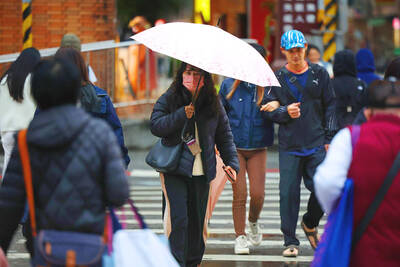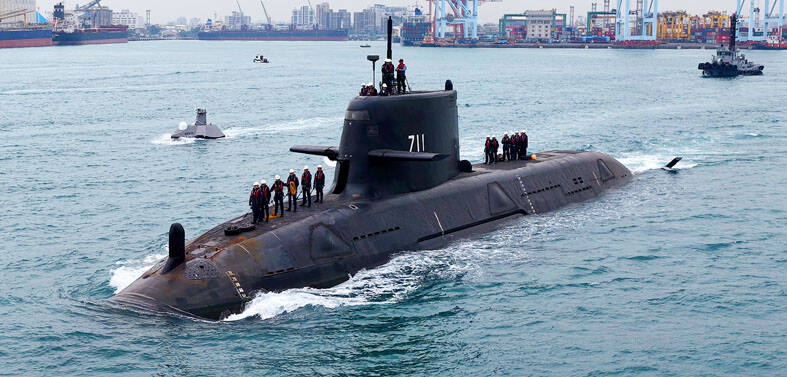The Control Yuan has urged the Environmental Protection Administration (EPA) to set up more air quality monitoring stations nationwide after an investigation initiated by Control Yuan members found that fine-particulate air pollution had become much more widespread in the country and was the cause of about 440 cardiovascular deaths in Taipei each year.
The investigation, launched last year by Control Yuan members Chou Yang-shan (周陽山) and Yin Jeo-chen (尹祚芊), found that while fine particles have been proven to have adverse health effects on humans, little research has been conducted thus far by the Academia Sinica, the National Science Council and the Department of Health (DOH) on the matter.
Singling out the department, the report said that the department had only carried out one research project pertaining to the hazardous pollutant over the past five years and had allocated no resources whatsoever to address the matter last year and this year.
“The department has also failed to make the best of the research advantages of the National Health Research Institutes, which put it on suspicion of neglecting a [major] problem,” the report said.
Fine particles are defined as particles with an aerodynamic diameter of or less than 2.5mm and can easily travel into a human’s respiratory tract and cardiovascular system through inhalation.
The main sources of such particles include sandstorms and emissions from petrochemical plants and vehicles.
Symptoms of exposure to fine-particulate pollution can include minor reactions, such as skin allergies, eye irritation and coughing, or more aggravated reactions in the form of asthma, rhinitis, conjunctivitis and cardiovascular disease.
Research statistics show that in the past 14 years, an average of 16 people from Taipei and New Taipei City (新北市) die of cardiovascular diseases whenever a sandstorm strikes the area.
In the region, a total of 4,400 people have died of similar diseases due to such storms, which usually occur between November and May, during the past decade.
The report said that based on EPA estimates, more than 30 percent of the fine particles in Taiwan came from other countries, such as China, where sandstorms run rampant, and that only 57 air quality monitoring stations have been established nationwide to keep track of the country’s fine particle concentration.
“The EPA should intensively set up more monitoring stations across Taiwan, in particular along the country’s western coast and at downwind locations from the Changhua Coastal Industrial Park, the Yunlin Offshore Industrial Park and the Kaoshiung Linhai Industrial Park, so that concerned authorities could receive an alert when air pollutants reach hazardous level and respond by calling off schools in those areas,” the report said.
The report also mentioned the passive attitude demonstrated by DOH officials and called on the department to put in place emergency countermeasures.

SHIPS, TRAINS AND AUTOMOBILES: The ministry has announced changes to varied transportation industries taking effect soon, with a number of effects for passengers Beginning next month, the post office is canceling signature upon delivery and written inquiry services for international registered small packets in accordance with the new policy of the Universal Postal Union, the Ministry of Transportation and Communications said yesterday. The new policy does not apply to packets that are to be delivered to China, the ministry said. Senders of international registered small packets would receive a NT$10 rebate on postage if the packets are sent from Jan. 1 to March 31, it added. The ministry said that three other policies are also scheduled to take effect next month. International cruise ship operators

NUMBERS IMBALANCE: More than 4 million Taiwanese have visited China this year, while only about half a million Chinese have visited here Beijing has yet to respond to Taiwan’s requests for negotiation over matters related to the recovery of cross-strait tourism, the Tourism Administration said yesterday. Taiwan’s tourism authority issued the statement after Chinese-language daily the China Times reported yesterday that the government’s policy of banning group tours to China does not stop Taiwanese from visiting the country. As of October, more than 4.2 million had traveled to China this year, exceeding last year. Beijing estimated the number of Taiwanese tourists in China could reach 4.5 million this year. By contrast, only 500,000 Chinese tourists are expected in Taiwan, the report said. The report

Temperatures are forecast to drop steadily as a continental cold air mass moves across Taiwan, with some areas also likely to see heavy rainfall, the Central Weather Administration (CWA) said. From today through early tomorrow, a cold air mass would keep temperatures low across central and northern Taiwan, and the eastern half of Taiwan proper, with isolated brief showers forecast along Keelung’s north coast, Taipei and New Taipei City’s mountainous areas and eastern Taiwan, it said. Lows of 11°C to 15°C are forecast in central and northern Taiwan, Yilan County, and the outlying Kinmen and Lienchiang (Matsu) counties, and 14°C to 17°C

STEERING FAILURE: The first boat of its class is experiencing teething issues as it readies for acceptance by the navy, according to a recent story about rudder failure The Hai Kun (海鯤), the nation’s first locally built submarine, allegedly suffered a total failure of stern hydraulic systems during the second round of sea acceptance trials on June 26, and sailors were forced to manually operate the X-rudder to turn the submarine and return to port, news Web site Mirror Daily reported yesterday. The report said that tugboats following the Hai Kun assisted the submarine in avoiding collisions with other ships due to the X-rudder malfunctioning. At the time of the report, the submarine had completed its trials and was scheduled to begin diving and surfacing tests in shallow areas. The X-rudder,